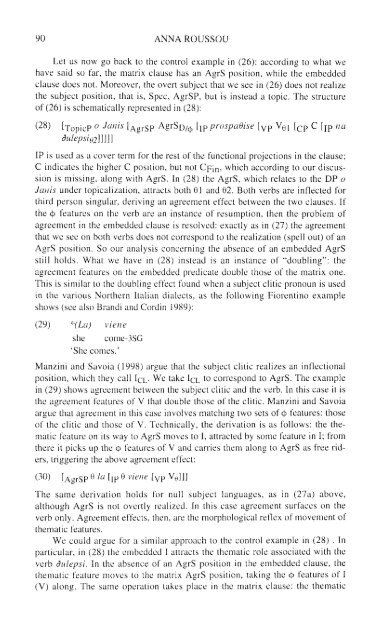Comparative Syntax of the Balkan Languages (Oxford ... - Cryptm.org
Comparative Syntax of the Balkan Languages (Oxford ... - Cryptm.org
Comparative Syntax of the Balkan Languages (Oxford ... - Cryptm.org
- No tags were found...
Create successful ePaper yourself
Turn your PDF publications into a flip-book with our unique Google optimized e-Paper software.
90 ANNA ROUSSOULet us now go back to <strong>the</strong> control example in (26): according to what wehave said so far, <strong>the</strong> matrix clause has an AgrS position, while <strong>the</strong> embeddedclause does not. Moreover, <strong>the</strong> overt subject that we see in (26) does not realize<strong>the</strong> subject position, that is, Spec, AgrSP, but is instead a topic. The structure<strong>of</strong> (26) is schematically represented in (28):(28) [fopicP ° Janis UgrSP A g rS D/(t> [\pprospaeise [ VP V e i [ CP C [jp no.dulepsi 6 2\\\\\IP is used as a cover term for <strong>the</strong> rest <strong>of</strong> <strong>the</strong> functional projections in <strong>the</strong> clause;C indicates <strong>the</strong> higher C position, but not Cpj n , which according to our discussionis missing, along with AgrS. In (28) <strong>the</strong> AgrS, which relates to <strong>the</strong> DP oJanis under topicalizalion, attracts both 01 and 62. Both verbs are inflected forthird person singular, deriving an agreement effect between <strong>the</strong> two clauses. If<strong>the</strong> 4> features on <strong>the</strong> verb are an instance <strong>of</strong> resumption, <strong>the</strong>n <strong>the</strong> problem <strong>of</strong>agreement in <strong>the</strong> embedded clause is resolved: exactly as in (27) <strong>the</strong> agreementthat we see on both verbs does not correspond to <strong>the</strong> realization (spell out) <strong>of</strong> anAgrS position. So our analysis concerning <strong>the</strong> absence <strong>of</strong> an embedded AgrSstill holds. What we have in (28) instead is an instance <strong>of</strong> "doubling": <strong>the</strong>agreement features on <strong>the</strong> embedded predicate double those <strong>of</strong> <strong>the</strong> matrix one.This is similar to <strong>the</strong> doubling effect found when a subject clitic pronoun is usedin <strong>the</strong> various Nor<strong>the</strong>rn Italian dialects, as <strong>the</strong> following Fiorentino exampleshows (see also Brandi and Cordin 1989):(29) '-'-(La) vieneshe come-3SG'She comes.'Manzini and Savoia (1998) argue that <strong>the</strong> subject clitic realizes an inflectionalposition, which <strong>the</strong>y call ICL- We take ICL to correspond to AgrS. The examplein (29) shows agreement between <strong>the</strong> subject clitic and <strong>the</strong> verb. In this case it is<strong>the</strong> agreement features <strong>of</strong> V that double those <strong>of</strong> <strong>the</strong> clitic. Manzini and Savoiaargue that agreement in this case involves matching two sets <strong>of</strong> features: those<strong>of</strong> <strong>the</strong> clitic and those <strong>of</strong> V. Technically, <strong>the</strong> derivation is as follows: <strong>the</strong> <strong>the</strong>maticfeature on its way to AgrS moves to I, attracted by some feature in I; from<strong>the</strong>re it picks up <strong>the</strong>
















